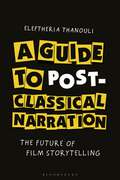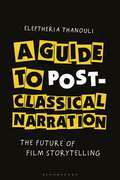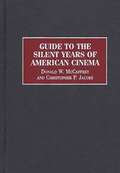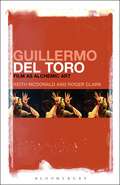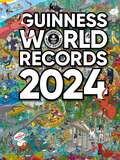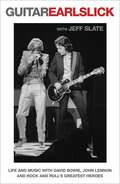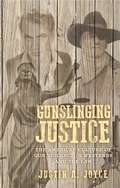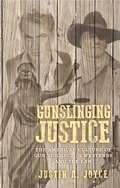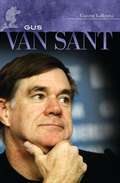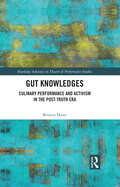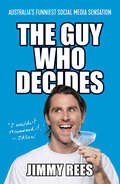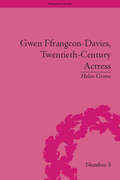- Table View
- List View
Guide to Minecraft Dungeons
by Mojang ABThis companion guide to the game has been created especially for heroes who intend to vanquish the Arch-Illager and his evil illager minions. It contains: - strategy tips for all the malicious mobs you'll need to defeat - hints about how to get your hands on helpful items and loot
Guide to Minecraft Legends
by Mojang ABTHE OFFICIAL GUIDE TO MINECRAFT LEGENDS – THE ALL-NEW ACTION STRATEGY GAME FROM MOJANG STUDIOS. This guide will inspire and guide heroes on how to create vital alliances and lead new allies in thrilling battles to defend the Overworld from the piglin invasion, with insight from Minecraft Legends’ game developers. It contains:
A Guide to Post-classical Narration: The Future of Film Storytelling
by Dr. Eleftheria ThanouliIn A Guide to Post-classical Narration, Eleftheria Thanouli expands and substantially develops the innovative theoretical work of her previous publication, Post-classical Cinema: an International Poetics of Film Narration (2009). A Guide to Post-classical Narration: The Future of Film Storytelling presents a concise and comprehensive overview of the creative norms of the post-classical mode of narration. With dozens of cases studies and hundreds of color stills from films across the globe, this book provides the definitive account of post-classical storytelling and its techniques. After surfacing in auteur films in varied production milieus in the 1990s, the post-classical options continued to gain ground throughout the 2000s and 2010s, gradually fertilizing several mainstream productions in Hollywood. From Lars von Trier's Europa (1991) to Zack Snyder's Army of the Dead (2021) and Baz Luhrmann's Elvis (2022), the post-classical narration has shown not only impressive resilience but also tremendous creativity in transforming its key formal principles, such as fragmented and multi-thread plotlines, hypermediated realism, parody, graphic frame construction, complex chronology, and intense self-consciousness. Through the meticulous textual analysis of the post-classical works, Eleftheria Thanouli addresses head-on a series of methodological questions in narrative research and brings the tradition of historical poetics back into the limelight. By reinforcing her previous work with numerous new films as well as more nuanced narrative terms and concepts, she not only strengthens her position on post-classical cinema but also establishes the relevance of formalist analysis in the study of film today.
A Guide to Post-classical Narration: The Future of Film Storytelling
by Dr. Eleftheria ThanouliIn A Guide to Post-classical Narration, Eleftheria Thanouli expands and substantially develops the innovative theoretical work of her previous publication, Post-classical Cinema: an International Poetics of Film Narration (2009). A Guide to Post-classical Narration: The Future of Film Storytelling presents a concise and comprehensive overview of the creative norms of the post-classical mode of narration. With dozens of cases studies and hundreds of color stills from films across the globe, this book provides the definitive account of post-classical storytelling and its techniques. After surfacing in auteur films in varied production milieus in the 1990s, the post-classical options continued to gain ground throughout the 2000s and 2010s, gradually fertilizing several mainstream productions in Hollywood. From Lars von Trier's Europa (1991) to Zack Snyder's Army of the Dead (2021) and Baz Luhrmann's Elvis (2022), the post-classical narration has shown not only impressive resilience but also tremendous creativity in transforming its key formal principles, such as fragmented and multi-thread plotlines, hypermediated realism, parody, graphic frame construction, complex chronology, and intense self-consciousness. Through the meticulous textual analysis of the post-classical works, Eleftheria Thanouli addresses head-on a series of methodological questions in narrative research and brings the tradition of historical poetics back into the limelight. By reinforcing her previous work with numerous new films as well as more nuanced narrative terms and concepts, she not only strengthens her position on post-classical cinema but also establishes the relevance of formalist analysis in the study of film today.
Guide to the Cinema (Reference Guides to the World's Cinema)
by Peter RistThis new volume in the Greenwood Press series Reference Guides to the World's Cinema discusses the films and personalities of the Canadian cinema. This guide encompasses the diverse output of both the English and French Canadian communities and includes 175 films and 125 filmmakers and actors. Alphabetically arranged entries discuss important films, actors, directors, shorts, and a number of experimental films. With few exceptions, films are included only if their production company was incorporated in Canada. Similarly, filmmakers and actors represent people who have worked primarily in Canada.This guide will interest scholars, students, and film buffs. Brief bibliographies after each entry provide sources for further reading. Three appendixes provide additional information regarding Canadian born filmmakers and actors excluded from the main text, winners of Canadian film awards, and a listing of the top ten Canadian films.
Guide to the Cinema of Spain (Reference Guides to the World's Cinema)
by Marvin D'LugoThis guide to Spanish film documents the film industry's interpretation of the isolating effects of the cultural traditionalism of the early twentieth century to the expanding international popularity of such films as Trueba's Belle Epoque, Aranda's Amantes, and Bigas Luna's Jamón, Jamón, and such actors as Victoria Abril, Carmen Maura, and Antonio Banderas. This is the first volume in a new Greenwood series that discusses, historically and critically, films, directors, and actors in film industries throughout the world. Each volume will include a detailed historical introduction and will provide an in-depth treatment of the most important films and individuals involved in the industry. End-of-entry bibliographies provide sources for further reading and appendixes provide additional useful information. The Guides will be valuable to scholars, students, and film buffs.Spanish cinema is in many ways a microcosm of the tensions and conflicts that have shaped the evolution of the nation over the course of this century. Spanish film as a cultural institution is rarely divorced from the political and social currents that have shaped the larger Spanish culture torn as it was between tendencies of localism and internationalism. It languished in industrial and artistic underdevelopment for many years under Franco; it is now, however, experiencing international recognition while remaining rooted in the specificity of its own popular cultural styles.
Guide to the Silent Years of American Cinema (Reference Guides to the World's Cinema)
by Christophe P. Jacobs Donald McCaffreyThe latest offering from the Reference Guides to the World's Cinema series, this critical survey of key films, actors, directors, and screenwriters during the silent era of the American cinema offers a broad-ranging portrait of the motion picture production of silent film. Detailed but concise alphabetical entries include over 100 film titles and 150 personnel. An introductory chapter explores the early growth of the new silent medium while the final chapter of this encyclopedic study examines the sophistication of the silent cinema. These two chapters outline film history from its beginnings until the perfection of synchronized sound, and reflect upon the themes and techniques established with the silent cinema that continued into the sound era through modern times.The annotated entries, alphabetically arranged by film title or personnel, include brief bibliographies and filmographies. An appendix lists secondary but important movies and their creators. Film and popular culture scholars will appreciate the vast amount of information that has been culled from various sources and that builds upon the increased studies and research of the past ten years.
Guillermo del Toro: Film as Alchemic Art
by Roger Clark Keith McDonaldA critical exploration of one of the most exciting, original and influential figures to emerge in contemporary film, Guillermo del Toro: Film as Alchemic Art is a major contribution to the analysis of Guillermo del Toro's cinematic output. It offers an in-depth discussion of del Toro's oeuvre and investigates key ideas, recurrent motifs and subtle links between his movies. The book explores the sources that del Toro draws upon and transforms in the creation of his rich and complex body of work. These include the literary, artistic and cinematic influences on films such as Pan's Labyrinth, The Devil's Backbone, Cronos and Mimic, and the director's engagement with comic book culture in his two Hellboy films, Blade II and Pacific Rim. As well as offering extensive close textual analysis, the authors also consider del Toro's considerable impact on wider popular culture, including a discussion of his role as producer, ambassador for 'geek' culture and figurehead in new international cinema.
Guillermo del Toro: Film as Alchemic Art
by Roger Clark Keith McDonaldA critical exploration of one of the most exciting, original and influential figures to emerge in contemporary film, Guillermo del Toro: Film as Alchemic Art is a major contribution to the analysis of Guillermo del Toro's cinematic output. It offers an in-depth discussion of del Toro's oeuvre and investigates key ideas, recurrent motifs and subtle links between his movies. The book explores the sources that del Toro draws upon and transforms in the creation of his rich and complex body of work. These include the literary, artistic and cinematic influences on films such as Pan's Labyrinth, The Devil's Backbone, Cronos and Mimic, and the director's engagement with comic book culture in his two Hellboy films, Blade II and Pacific Rim. As well as offering extensive close textual analysis, the authors also consider del Toro's considerable impact on wider popular culture, including a discussion of his role as producer, ambassador for 'geek' culture and figurehead in new international cinema.
Guinness World Records 2024
by Guinness World RecordsDive into thousands of new and classic records, with topics as diverse as rollercoasters, robots, movie props and gaming. The theme of this year's edition is the BLUE PLANET, so take the plunge with our opening chapters, as we encounter bizarre and deadly sea creatures, swim through the largest coral reefs and explore the seabed for shipwrecks. Rod Hunt's fourth and final cover in his collectable series also conjures an aquatic wonderland packed with record holders - how many can you spot?
Guitar: A rock 'n' roll tell-all autobiography from David Bowie's sideman
by Jeff Slate Earl SlickRead this rollicking rock 'n' roll memoir of the last 50 years of rock history, from David Bowie's longest serving lead guitarist and legendary sideman, Earl Slick. He's played with everyone from John Lennon to the New York Dolls – and he's got the stories to prove it.----‘Earl is a legendary guitar star. His playing is earth, timeless and never less than stellar’ DAVID BOWIE ‘You play mean ass blues for a skinny ass white boy’ BUDDY GUY ‘Had a good night out did we . . .?’ JOHN LENNON Earl Slick was barely out of his teens when David Bowie hired him to play guitar on the ground-breaking 1974 Diamond Dogs tour. It marked the beginning of a relationship that would endure through thick and thin for the next forty years. Gracing classic albums like Young Americans, Station to Station and the 2013 comeback, The Next Day, Slick played on the tour that followed Bowie’s smash hit Let’s Dance album and was at his side for the epic Glastonbury show in 2000. But it wasn’t just Bowie. The young guitarist was in John Lennon’s band at the time of the former Beatle’s tragic murder. Other collaborations read like a roll call of rock ‘n’ roll royalty including Mick Jagger, The Cure, George Harrison, Ringo Starr, Joe Cocker, Buddy Guy, Ian Hunter, David Coverdale and Eric Clapton. And in the ‘80s he became an MTV star in his own right with the success of Phantom, Rocker and Slick. Through it all he lived the rock ‘n’ roll life to the hilt. Until it nearly killed him. One of rock’s great sidemen, Earl Slick was in the room when music history was made. Guitar takes us there, shining a light on superstars like Bowie and Lennon, while recounting the extraordinary story of the boy from New York City who became a real-life Johnny B. Goode.
The Gulf in World History: Arabian, Persian and Global Connections
by Allen James FromherzProvides a concise up-to-date introduction to and overview of black nationalism in American history
The Gulf in World History: Arabian, Persian and Global Connections
by Allen James FromherzAnalyses of Rancière’s philosophy and its potential for understanding the conversation between contemporary politics and art cinema
Gun Crazy (BFI Film Classics)
by Jim KitsesJoseph H. Lewis's 'Gun Crazy' is the story of two young lovers who embark on a crime spree. For this book, Kitses researched widely into the film production's history and explored its connection to the crime film tradition and to the dark underside of American society.
Gun Crazy (BFI Film Classics)
by Jim KitsesJoseph H. Lewis's 'Gun Crazy' is the story of two young lovers who embark on a crime spree. For this book, Kitses researched widely into the film production's history and explored its connection to the crime film tradition and to the dark underside of American society.
Gunslinging justice: The American culture of gun violence in Westerns and the law
by Justin A. JoyceThis book is a cultural history of the interplay between the Western genre and American gun rights and legal paradigms. From muskets in the hands of landed gentry opposing tyrannical government to hidden pistols kept to ward off potential attackers, the historical development of entwined legal and cultural discourses has sanctified the use of gun violence by private citizens and specified the conditions under which such violence may be legally justified. Gunslinging justice explores how the Western genre has imagined new justifications for gun violence which American law seems ever-eager to adopt. Cover design by Jared Scott.
Gunslinging justice: The American culture of gun violence in Westerns and the law
by Justin A. JoyceThis book is a cultural history of the interplay between the Western genre and American gun rights and legal paradigms. From muskets in the hands of landed gentry opposing tyrannical government to hidden pistols kept to ward off potential attackers, the historical development of entwined legal and cultural discourses has sanctified the use of gun violence by private citizens and specified the conditions under which such violence may be legally justified. Gunslinging justice explores how the Western genre has imagined new justifications for gun violence which American law seems ever-eager to adopt. Cover design by Jared Scott.
Gus Van Sant: His Own Private Cinema (Modern Filmmakers)
by Vincent LoBruttoThis incisive book provides an in-depth critical and biographical study of the artistic range of film director Gus Van Sant.Arranged chronologically, Gus Van Sant: His Own Private Cinema provides a comprehensive overview of the life and art of this talented director, covering his mainstream, commercial, and avant-garde projects. More than a biography, the book examines Van Sant's incredibly diverse body of work, exploring the influence of his open homosexuality; of fine art, literature, and music; and of the range of cinema styles to which he has been exposed.Stressing Van Sant's wide-ranging content, genre, style, and cinematic presentation, author Vincent LoBrutto details the filmmaker's autobiographical tendencies and how he uses the film craft, literature, popular music, and fine arts to create his movies. The book dissects ways in which each of his films reflects Van Sant's sexual orientation, whether the individual film has a gay theme or not. Because of its importance to Van Sant's films, the book also offers a history of gay culture, past and present, covering its influence on art, music, theater, and dance, as well as community, activism, and prejudice.
Gus Van Sant: His Own Private Cinema (Modern Filmmakers)
by Vincent LoBruttoThis incisive book provides an in-depth critical and biographical study of the artistic range of film director Gus Van Sant.Arranged chronologically, Gus Van Sant: His Own Private Cinema provides a comprehensive overview of the life and art of this talented director, covering his mainstream, commercial, and avant-garde projects. More than a biography, the book examines Van Sant's incredibly diverse body of work, exploring the influence of his open homosexuality; of fine art, literature, and music; and of the range of cinema styles to which he has been exposed.Stressing Van Sant's wide-ranging content, genre, style, and cinematic presentation, author Vincent LoBrutto details the filmmaker's autobiographical tendencies and how he uses the film craft, literature, popular music, and fine arts to create his movies. The book dissects ways in which each of his films reflects Van Sant's sexual orientation, whether the individual film has a gay theme or not. Because of its importance to Van Sant's films, the book also offers a history of gay culture, past and present, covering its influence on art, music, theater, and dance, as well as community, activism, and prejudice.
Gut Knowledges: Culinary Performance and Activism in the Post-Truth Era (Routledge Advances in Theatre & Performance Studies)
by Kristin HuntThis book examines historical and contemporary activist alimentary performance with an eye toward, or perhaps a taste for, what these performance modes can reveal about changing relationships between the senses, truth, justice, and ethical action amid the post-truth era’s destabilization of shared notions of truth. This inquiry emerges in response to an urgent need to understand how multisensory models of knowledge, truth, and justice can be ethically employed to nurture a more just society. Alongside this goal is a drive to understand the ways in which these modes of performance are being co-opted by authoritarians, white supremacists, anti-science activists, and others to shore up injustice, promote misinformation, and anxiously guard existing systems of power and privilege. From white supremacist milk-drinking performances to liberatory uses of culinary performance as pedagogy, Kristin Hunt analyzes both disturbing and inspiring alimentary events to understand how performers, cooks, scholars, artists, and activists can effectively cultivate models of alimentary performance that center plenitude, joy, and justice while pushing back against models rooted in anxiety, diminishment, and cruelty. The text should be of interest for students in performance studies, contemporary theatre, and theatre history as well as courses in food studies and popular culture.
Gut Knowledges: Culinary Performance and Activism in the Post-Truth Era (Routledge Advances in Theatre & Performance Studies)
by Kristin HuntThis book examines historical and contemporary activist alimentary performance with an eye toward, or perhaps a taste for, what these performance modes can reveal about changing relationships between the senses, truth, justice, and ethical action amid the post-truth era’s destabilization of shared notions of truth. This inquiry emerges in response to an urgent need to understand how multisensory models of knowledge, truth, and justice can be ethically employed to nurture a more just society. Alongside this goal is a drive to understand the ways in which these modes of performance are being co-opted by authoritarians, white supremacists, anti-science activists, and others to shore up injustice, promote misinformation, and anxiously guard existing systems of power and privilege. From white supremacist milk-drinking performances to liberatory uses of culinary performance as pedagogy, Kristin Hunt analyzes both disturbing and inspiring alimentary events to understand how performers, cooks, scholars, artists, and activists can effectively cultivate models of alimentary performance that center plenitude, joy, and justice while pushing back against models rooted in anxiety, diminishment, and cruelty. The text should be of interest for students in performance studies, contemporary theatre, and theatre history as well as courses in food studies and popular culture.
The Guy Who Decides: Australia's funniest social media sensation
by Jimmy ReesHave you ever wondered who made the call on imperial measurements, collective nouns for animals, horoscopes and Olympic sports? What were they thinking? And why do parents insist on naming their children after cities, cars and smoothie ingredients (Paris, Mercedes and Kale, we're looking at you...)?The Guy Who Decides, Jimmy's first book for adult readers, expands upon his hilarious videos lampooning the absurd conventions and rules of our modern world through the outlandish characters of The Guy Who Decides (who appears to be several martinis deep at all times) and his underling, Jason. Meanwhile, from Brighton to Byron Bay and beyond, prepare to meet a bunch of Australians who are as funny/scary as they are uproariously familiar!
Gwen Ffrangcon-Davies, Twentieth-Century Actress (Dramatic Lives)
by Helen GrimeGwen Ffrangcon-Davies is a paradox; a famous actress whose career spanned most of the twentieth century she is now largely forgotten. Drawing on material held in Ffrangcon-Davies's personal archive, Grime argues that the representation of the actress, on and off the stage, can be read in terms of its constructions of normative female behaviours.
Gwen Ffrangcon-Davies, Twentieth-Century Actress (Dramatic Lives #3)
by Helen GrimeGwen Ffrangcon-Davies is a paradox; a famous actress whose career spanned most of the twentieth century she is now largely forgotten. Drawing on material held in Ffrangcon-Davies's personal archive, Grime argues that the representation of the actress, on and off the stage, can be read in terms of its constructions of normative female behaviours.
Gwen Raverat: Friends, Family and Affections
by Frances Spalding'The best of these Darwins is that they are cut out of rock - three taps is enough to convince one how immense is their solidarity.' So wrote Virginia Woolf affectionately of Gwen Raverat, the granddaughter of Charles Darwin. In this first full biography, Frances Spalding looks beyond the artist Gwen Raverat's childhood memoir; Period Piece, and creates a fascinating and moving portrait of Charles Darwin's granddaughter. She explores her Darwin inheritance; her conflicts when she moves beyond her home environment to enter the Slade School of Art; her encounter with post-Impressionism; and her friendships with Stanley Spencer, Rupert Brooke and members of the Bloomsbury set. At each stage, Gwen's artistic creativity is interwoven with her relationships and circumstances. She helps revive the medium of wood-engraving and with her husband, Jacques Raverat, celebrates the South of France in the art they produce while living in Venice. Drawing on a huge cache of unpublished papers, Spalding brings us a life lived with bravery, humour; realism and integrity, surrounded by a remarkable cast of relatives, friends and associates.


